Passenger Cars and Military Jeeps
East Block Communist Era Production
May sell the collection to the highest bidder
(All vehicles are driven occasionally)
Contact: czes@CzeslawRuszowski.com or czar@bokar.com
-
Syrena 105 Lux Manufactured in 1976
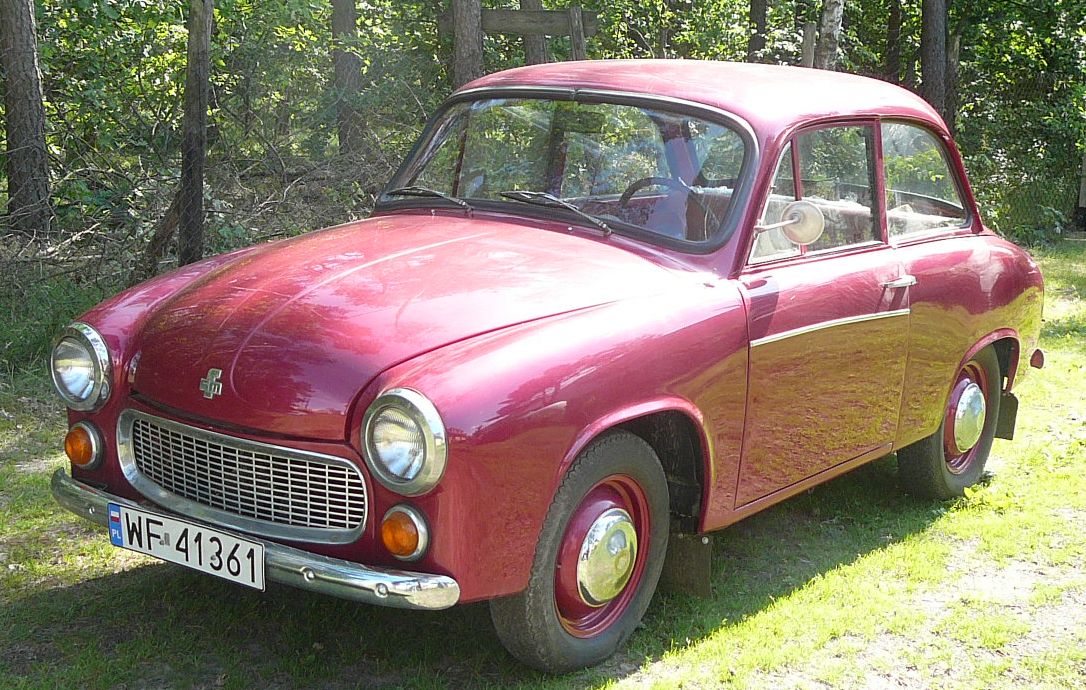 |

|
The beginning of Polish Automobile production after the Second World War
The general history of the vehicle:
The Syrena was a Polish automobile model first exhibited at the Poznań Trade Fair in 1955 and manufactured from 1957 to 1972 by the Fabryka Samochodów Osobowych (FSO) in Warsaw and from 1972 to 1983 by Fabryka Samochodów Małolitrażowych (FSM) in Bielsko-Biała. 177,234 were made by FSO and 344,077 by FSM, a total of 521,311. During its remarkably long production run it underwent only minor modifications.
The Syrena was produced in various models: 100, 101, 102, 103, 104, while the most popular model was the 105. All were 2-door sedans with two-stroke engines, initially of two cylinders. In 1965 the Syrena received a larger 3 cylinder engine.
From 1968 a prototype model named laminat was produced. A van called Syrena Bosto and a pick-up R20 were also produced. A coupe Syrena Sport and a hatchback Syrena 110 (in 1966) remained prototypes only.
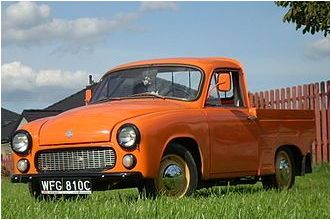 |
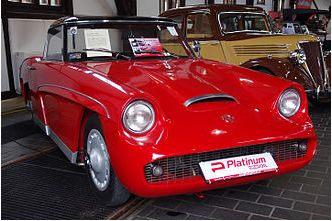 |
A Siren is a mermaid who, according to the legend, protects the river Wisła and the Polish capital city, Warsaw. She is featured on the city's coat of arms. Also a diminutive name Syrenka (little siren) is commonly used for the car in Poland.
In 1960 a prototype Syrena Sport was produced with a fibreglass body and a 4-stroke 4-cylinder engine. However the model was not put into production.
The 105 was the last Syrena design. It was produced from 1972 to 1983 by the FSM factory in Bielsko Biala . Unlike its predecessors it had regular front doors instead of "suicide" ones. The "Lux" version, produced from 1974, had the gear lever and handbrake between the front seats. The 105 served as a basis for two other models – Syrena R-20, which was a pick-up and a van – Bosto.
A 1983 FSM Syrena 105L finished in yellow was featured in a series 10 episode of the British television program Wheeler Dealers. Presenter Mike Brever purchased the car in Poland for zł 7,000 (the equivalent of £1,400) and drove it back to the show's UK-based workshop where it underwent repairs and upgrades by mechanic Edd China. The colour was changed to red and white in homage to the Polish flag (coincidentally, also Poland's traditional racing colors). The completed car was driven to the Polish embassy where ambassador Witold Sobków took a ride with them. The car was later sold for £8,000 to the bubble car museum in Lincolnshire.
Syrena Technical specifications and More info
- Fiat 126p Manufactured in 1991
 |
 |
The Fiat 126 (Type 126) is a rear-engined, small economy or city car, introduced in October 1972 at the Turin Auto Show as a replacement for the Fiat 500. The majority of 126s were produced in Bielsko-Biała (Poland) as the Polski Fiat 126p, where production continued until year 2000. In many markets Fiat stopped sales of the 126 in 1993 in favour of their new front-engined Cinquecento.
At a vehicle length of 3.05 metres, the Fiat 126 is almost exactly the same size as the original British Mini, and although it came to market 14 years later, production ended in the same year (2000), and its total sales of almost 4.7 million units were in close range of the Mini's 5.4 million.
History:
The 126 used much of the same mechanical underpinnings and layout as its Fiat 500 rear-engined predecessor with which it shared its wheelbase, but featured an all new bodyshell resembling a scaled-down Fiat 127, also enhancing safety.
Engine capacity was increased from 594 cc to 652 cc at the end of 1977 when the cylinder bore was increased from 73.5 to 77 mm. Claimed power output was unchanged at 23 hp (17 kW), but torque was increased from 39 N·m (29 lb·ft) to 43 newton metres (32 lb·ft). The 594 cc engines were still available in early 1983 production.
A subsequent increase took the engine size to 704 cc in new "restyling" model Fiat 126 Bis (1987–1991), with 26 hp (19 kW) of motive power.
In Italy, the car was produced in the plants of Cassino and Termini Imereseuntil 1979. By this time 1,352,912 of the cars had been produced in Italy.
The car continued however to be manufactured by FSM in Poland, where it was produced from 1973 to 2000 as the Polski Fiat 126p. Even after the introduction of the 126 Bis (a 126p with water-cooled 704 cc engine of indigenous Polish construction), the original model continued to be produced for the Polish market. The car was also produced under licence by Zastava in Yugoslavia. In 1984, the 126 received a facelift, giving it plastic bumpers (for all versions) and a new dashboard. This model named Fiat 126p FL. In 1994, the 126p received another facelift, and some parts from the Fiat Cinquecento, this version was named 126 EL. The 126 ELX introduced a catalytic converter.
Despite clever marketing, the 126 never achieved the frenzied popularity of the 500. The total number of 126 produced is: 1,352,912 in Italy, 3,318,674 in Poland, 2,069 in Austria, and an unknown number in Yugoslavia. For a brief period in the early 1990s, a German company called POP also offered convertible versions of the 126 BIS. Two models were offered: a lesser equipped one called the "POP 650" and a more luxurious model called the "POP 2000".
The car was produced in Poland under the brand Polski Fiat 126p (literally in English: Polish Fiat 126p) between 1973 and 2000. At first it was almost identical with the basic model: differences included a higher chassis, a modified grille on the back, and the front blinkers that were white in Italy but orange for other markets. To distinguish it from the original Italian car, the letter "p" was added to its name. It was produced by Fabryka Samochodów Małolitrażowych (FSM) in Bielsko-Biała and Tychy under Italian Fiat licence. Throughout the 1980s the 126p was continuously modified. First it received upgraded brakes and new wheels from Italian Fiat, hazard blinkers were added to meet new law requirements, in 1985 tail fog light and factory back-up light were added to then standard plastic bumpers, an electronic ignition system and alternator replaced undersized generator around 1987. The factory battery in 126p had only 35 Amp-hour capacity which combined with undersized generator resulted in never fully charged battery unless someone drove the car without stopping for extended time period. Some owners upgraded to a 45 Amp-hour battery from Fiat 125p (1.5 Liter engine) to improve the cold start reliability. Due to a relatively low price it was very popular in Poland and was arguably the most popular car there in the 1980s. Its very small size gave it the nickname maluch ("the small one","small child", pronounced [ˈmaluh]). The nickname became so popular that in 1997 it was accepted by the producer as the official name of the car.
It was exported to many Eastern Bloc countries and for several years it was one of the most popular cars in Poland and in Hungary as well. It also found a minor market in Australia between 1989 and 1992, under the name FSM Niki. During that period it was Australia's cheapest car. There was a convertible version developed for Australian market.
Throughout the 1980s there were several experimental prototypes developed in Poland. A cargo version called "Bombel" (literally can mean "a bubble" but referred to a familial and alternative term for "small child") for its fiberglass bubble shaped cargo enclosure, an off road version propelled by caterpillar tracks and a front wheel drive, front engine, with longer front end and flat cargo area in the rear where the original 126 had engine. The rear of this prototype was similar to the 126 Bis which also had a rear hatch for accessing a cargo space that was created by building a flat water-cooled engine under the floor. In 1987 the 126 Bis went into production.
There was also an attempt at installing a small diesel engine (due to gasoline rationing) in the classic 126p body. It is also a popular platform for electric engine and motorcycle engine swaps .
Fiat 126p Technical specifications and More info
- Fiat 125p Manufactured in 1976
 |
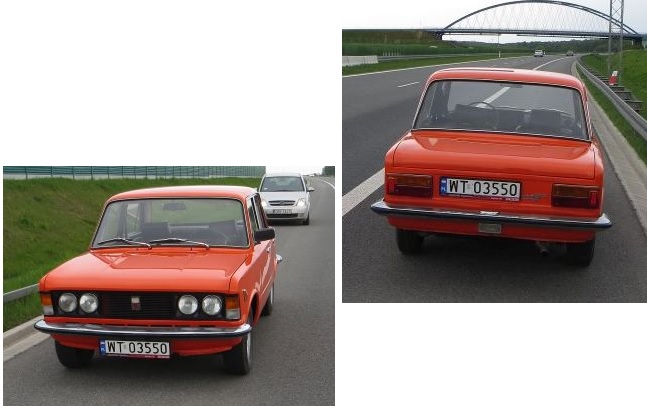 |
The before last Polish passenger car produced in Communist Poland
The general history of the vehicle:
The Polski Fiat 125p is a motor vehicle manufactured between 1967 and 1991 in the People's Republic of Poland (1968–1990) and the Republic of Poland (1990–1991) by the state-owned manufacturer Fabryka Samochodów Osobowych ("FSO") under a license agreement with Fiat. It was a simplified variation of the Fiat 125, with engines and mechanicals from the Fiat 1300/1500. To distinguish between the models, Fiat and FSO revived the marque Polski Fiat. After the termination of the license agreement, the car was also branded as the FSO 1300, FSO 1500 or FSO 125p.
History and development
In the 1960s, the only passenger car manufacturer in socialist Poland was the FSO in Warsaw, which manufactured the dated Syrena small car and the Warszawa, a larger model whose roots could be traced back to 1940s. Even within the realities of a centrally planned, socialist economy, the need for a replacement was felt. Although Warszawa-based replacements had been under development within the FSO, the authorities decided to pursue talks with the Italian Fiat, which was seeking to expand its international presence by establishing production in the countries of the Eastern Bloc.
On the 22 December 1965, a license agreement was signed concerning manufacturing of intermediate-sized cars in Poland. The automobile concerned was a model specially devised for production in Poland, combining the body and braking system of the newly launched Fiat 125 with the driveline and other chassis elements from the retired Fiat 1300/1500. The FSO plant had to be refurbished to be able to handle the assembly of a modern car, so world-class machinery was ordered from Western companies. FSO's over 100 Polish suppliers were also involved in the effort, as well as other manufacturers from the Eastern European assembling Fiat-licensed models – Crvena Zastava works in Yugoslavia and the newly organised VAZ in the Soviet Union. The production preparation process took almost two years, with the assembly of pre-production test series from parts imported from Italy commencing on 28 November 1967. By the end of the year, 75 such cars were assembled.
Cars
There were two main versions, differing in the engine employed: 1300 (1295 cc, 60 hp (45 kW) / 44 kW) or 1500 (1481 cc, 75 hp / 51.5 kW). The 1300 model entered production in 1968 and the 1500 in 1969. The 1300 ceased production in the 1980s.
Polish cars differed in detail from Italian ones: most visibly there were four round headlights instead of four square ones, simpler bumpers and front grill, orange color front turn signal lenses, simpler body sheet metal stampings, and the old Fiat 1300/1500 chassis and interior. A less visible but significant change in the Polski Fiat was a safer flat fuel tank above the rear axle, instead of Fiat's vertical tank on the rear right-hand side. It also had more durable all-around disc brakes.
Unlike the Fiat 125, the car was also available as an estate (PF 125p Kombi), and a pickup developed in Poland after Italian Fiat 125 production ended in 1972. The station wagon won the 1978 Estate Car of the Year Award in the United Kingdom.
A few cars were made with original Italian 1600 cc (PF 125p Monte Carlo) and 1800 cc (PF 125p Akropolis) engines, intended mostly for racing. An unusual variant built in a small series was a lengthened cabriolet with three rows of seats, used by the tourist bureau in Warsaw for sightseeing.
There was a minor restyling in 1973, when the chrome front grille was replaced with a black plastic one, and in 1975, when a new black plastic grille arrived along with new turn indicators, enlarged horizontal rear lamps (instead of pairs of thin vertical ones), and a slightly modernised interior: a new plastic dashboard and steering wheel, hubcaps featuring modern stamped patterns, new bumpers with horizontal strips of rubber which replaced paired vertical guards. The power of both engines was also raised by 3.7 kW. From 1983, the car was produced as the FSO 125p 1500/1300. In the late 1980s the 125p received its last upgrade in form of power train from the FSO Polonez and a new instrument cluster featuring round gauges in place of the classic Fiat speedometer.
The car was produced until 26 June 1991 (to fulfill factory preproduction sales obligation – the communist prepayments system, system przedpłat); in total, 1,445,689 were manufactured. By that time the design was 24 years old and used mechanicals which were essentially 30 years old, with only minor improvements.
Successor
From 1978, a version with an entirely new body was available – the FSO Polonez. The Polonez survived with improvements until 2002.
Fiat 125p Technical specifications and More info
- Trabant 601 Manufactured in 1990
 |
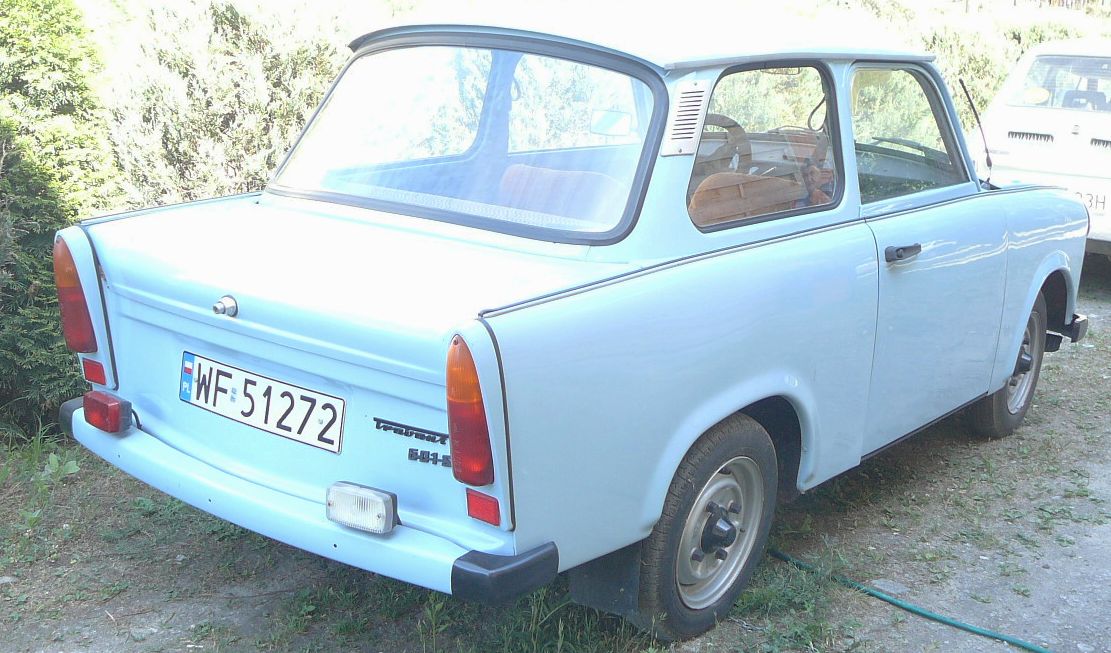 |
The car which was going to be an affordable for everyone in East Germany
Facts and History That Makes This Car Unique:
Great investment that will only increase in value.
Although Trabants are rare in the US, we have a growing national club called TrabantUSA where membership is free and we support the preservation of these unique vehicles. Parts are inexpensive and readily available, i.e. LDM Tuning and Reich Tuning etc. Free technical support is also available through our Trabant Yahoo group. DC Rally, sponsored by the International Spy Museum in Washington DC. It's free and a must for any Trabant enthusiast. The museum rewards every Trabi in attendance with a trophy, free lunch, money for gas and hotel. What other car club does that?
The History:
Trabi was the nickname of this popular East-German car in the Cold War East Block.
Light body 2 stroke 2 cylinder engine, very easy handle column shifter.
4 speed transmission.
No fuel pump. Gravity fed fuel with motorcycle like fuel switch. ON - OFF - RESERVE.
To check the fuel level, you have to use a measuring dipstick !
The car is so light that it needs no assistance from a Servo to have one of the best breaking systems of any car.
Each cylinder is supplied by it's own solenoid directly, ensuring the maximum direct connection between the solenoid and the spark plug,
The electronic ignition does away with the need for a distributor cap.
The car was considered the East German Beetle, and it was! Easy to maintain, easy to drive, easy to Live with.
The only Hard thing was to Get one of it. Usually there was a 3-4 years of waiting to get your dream machine, if you were lucky enough to get on THE WAITING LIST !!
The little car is really fun to drive. No wonder it was quite successful in the Rally Championships all over Europe .
Trabant 601L Technical specifications and More info
- Wartburg Manufactured in 1987
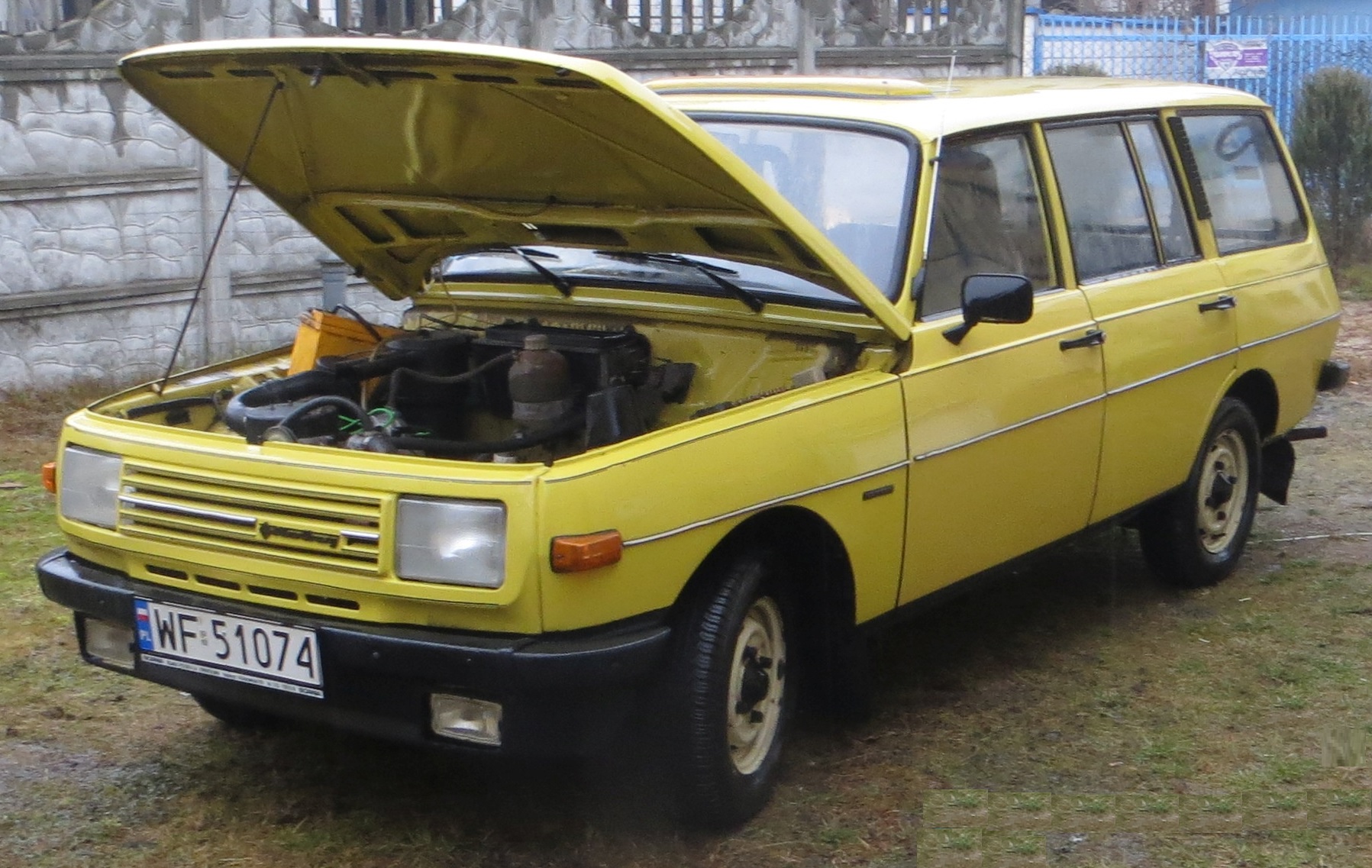 |
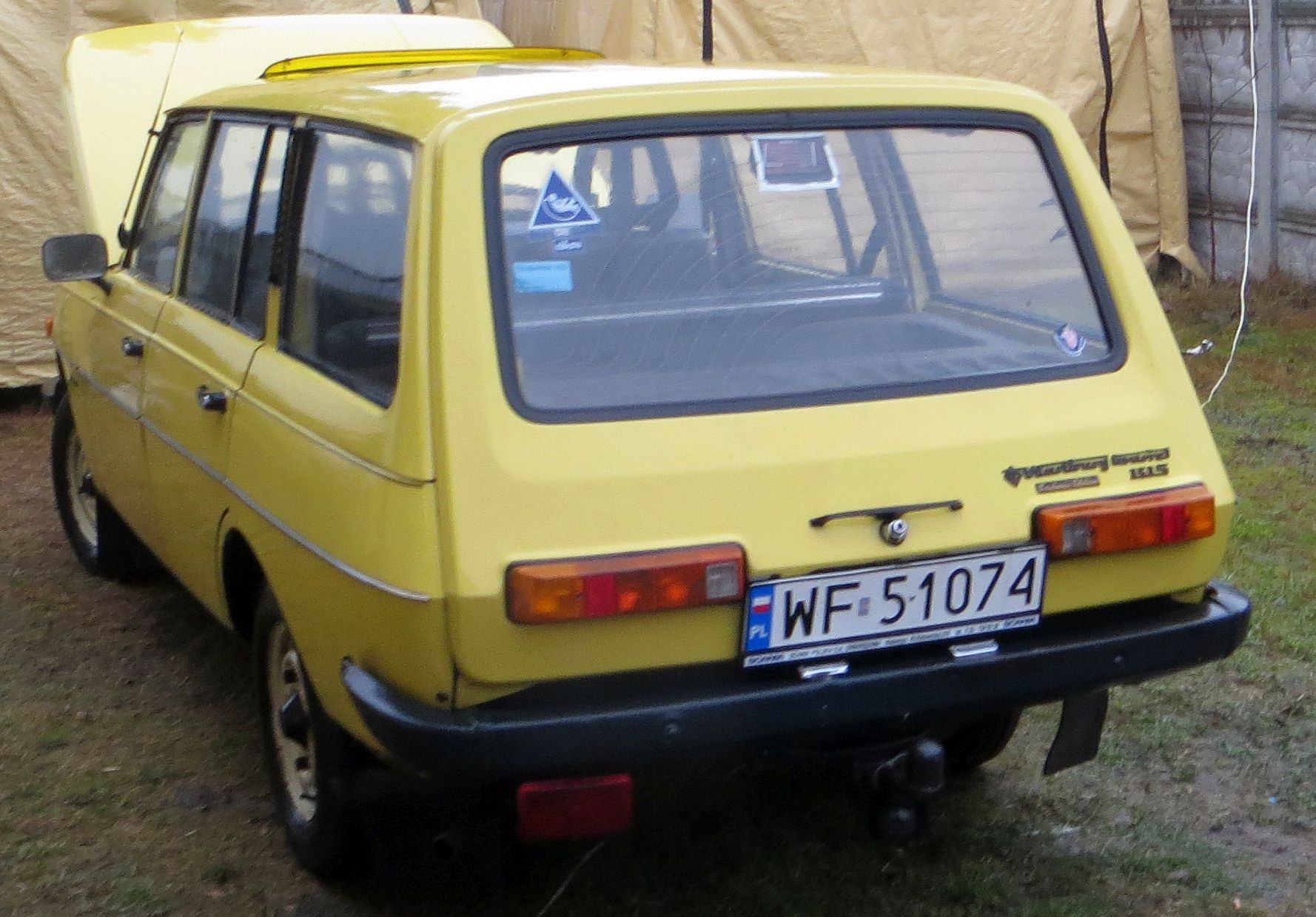 |
The Wartburg was a car marque manufactured in East Germany.
The name "Wartburg" derives from Wartburg Castle on one of the hills overlooking the town of Eisenach where the cars were manufactured.
From the 1950s, Wartburgs had a three-cylinder two-stroke engine with only seven major moving parts (three pistons, three connecting rods and one crankshaft).
History:
The marque dates back to 1898 when a car made by Automobilwerk Eisenach was named the Wartburgwagen. It consisted of a two-seating cane chair, four mudgards, two headlamps, and a two-cylinder, 765-cc engine. Its top speed was 25 mph (40 km/h). The name was dropped in 1904 when the company changed hands but re-appeared briefly in the early 1930s on the BMW 3/15 DA-3 Wartburg, which was BMW's first sports car.
Main usage of name
The name was revived in 1956 by VEB Automobilwerk Eisenach and given to an updated version of their IFA F9 car which had been in production since 1950. The new car had a more powerful version of the three-cylinder two-stroke engine driving the front wheels and a completely new body. By this time, Germany had been divided into two countries (the West and the East) and the Wartburg factory was in the communist East (GDR).
Exports to West Germany started in 1958, and by the early 1960s the car was exported to many other countries, including the United Kingdom and United States. Right hand drive models were first made in 1963 and exported to Cyprus, with British buyers being introduced to the car in 1964. However, just 550 examples (450 saloons and 100 estates) were sold in the UK. These were well equipped two-tone luxury models sold at the same price as a basic Austin Mini, appealing mostly to older people.
The 311 model was manufactured in a number of variations, including pickup, estate, and two-seater roadster. A convertible was advertised in the GDR in 1957 but its production never exceeded 350 units.
The engine was enlarged to 992 cc in 1962 and a completely new body was manufactured after 1966. This version, the 353, was sold as the Wartburg Knight in several countries, including the UK, where the estate model was sold as the Tourist. It remained on sale until 1976, by which time nearly 20,000 had been sold. This marked the end of right-hand drive Wartburgs, but left-hand drive versions continued to be imported to the UK and at least one model was converted to right-hand drive.
Also, in 1966, the gearbox gained synchromesh on all speeds and was designed to freewheel as a fuel efficiency and engine protection measure, which meant that the car did not benefit from engine braking. Because the engine was a two stroke unit, it relied on the passage of the petrol mixture (two-stroke oil and petrol, at a ratio of 1:50) to lubricate the engine. With the freewheel device disabled, the engine could be starved of lubricant and seize on long down-hill runs unless the throttle was opened briefly from time to time. Nevertheless, disengaging the freewheel device was recommended to give engine braking in snowy or icy conditions.
There are four editions of Wartburg 353:
- Wartburg 353 from 1966
- Wartburg 353W from 1975
- Wartburg 353W from 1983
- Wartburg 353S from 1985
There are three models of Wartburg 353 - Limousine (sedan), Tourist (combi) and Trans (pickup). The 353W modification had a new, round-shaped dashboard and black-coloured grille. It was also fitted with disc brakes on the front axle. The 353S modification featured new rectangular headlights integrated into the grille of a new shape. In the De Luxe version you can see electronic ignition, 5-speed gearbox, front and back fog lights, alarm system and central lock door. Usually this model can reach around 150-155 km/h. Moreover, the radiator was moved from behind the engine (353, 353W) to the classic position behind the grille.
The engine of the car was with 50, 55 or 57 HP (depending on the year of production and the carburettor type). Fuel economy was barely acceptable for run-about driving. The offer of Volkswagen to move a surplus engine assembly line to the GDR, to be paid off by manufacture, was accepted by the government on account of fuel economy. In 1988, the new model Wartburg 1.3 therefore replaced the old model 353S, featuring the reliable though bulky engine from the Volkswagen Golf. Being larger than the compact 2-stroke unit, this needed considerable reconstruction of the engine compartment.
Demise
The VW engine gave 64 horsepower. The new Wartburg's life was short, with the nail in its coffin being German reunification; production was inefficient and could not compete with West-German manufacturers. Production ended in April 1991, and the factory was acquired by Opel.
There are still some cars in drivable condition, and Wartburg owners' clubs exist throughout Europe. Some Wartburgs are still used as rally racing cars.
- Skoda Rapid Manufactured in 1988
 |
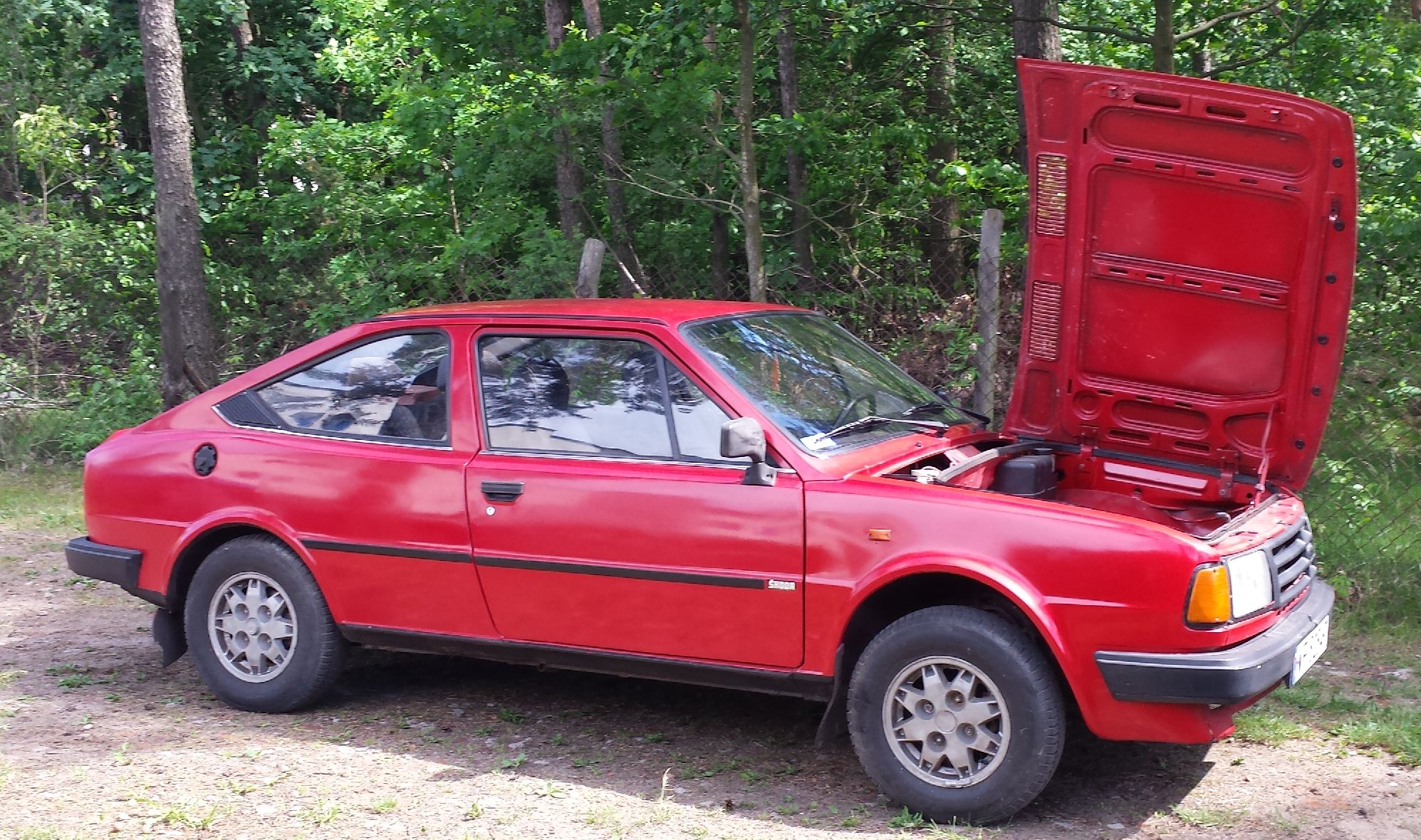 |
This article is about the 1984-1990 Škoda Rapid Coupé. For other versions, see Škoda Rapid.
The Škoda Rapid is a fastback coupé designed and built by AZNP in Czechoslovakia between 1984 and 1990. Based on the rear-engined Škoda 130/135/136 sedan, it was a replacement for the Škoda Garde coupe built between 1981 and 1984 itself based upon the Škoda 105/120 sedan design, which was also called the Rapid in the UK market. Some Garde/Rapid cars were sent to Ludgate Design & Development in Kent, United Kingdom, by Škoda to be converted into convertibles.
Although the Škoda sedans had a poor reputation for build quality and handling throughout Western Europe at the time, the Rapid was significant for bucking this trend being described as "the poor man’s Porsche" after Autocar and Motor defined the Škoda Rapid "a beginners' course to the 911", as it had a rear-mounted engine and rear-wheel drive, just like the Porsche 911.
Today the Škoda Rapid is gaining in popularity as a classic car with Garde and convertible models being most sought after. According to the website "How Many Left?", there were a total of 50 Škoda Rapids left on British roads in 2011.
The Rapid name was originally used on 1930s Škoda models, and was revived again in 2011 on a saloon for the Indian Market, based on the Volkswagen Vento, and in 2012 on a small family car for the international market.
The Rapid, and its predecessor Garde, were internally known as Type 743 models, with the later 135/136 Rapids being referred to as Type 747.
Specifications:
The Rapid used a unibody structure and a rear-engine, rear-wheel-drive layout. Front suspension was by double wishbones and coil springs. At the rear there were semi-trailing arms and coil springs, a major upgrade from the swing axle of earlier Škodas that gave safer and more predictable handling. Brakes were discs with four-pot calipers at the front, and drums at the rear.
The engine was a water-cooled, carburated, OHV inline four mounted longitudinally, slanted to the right and overhanging the rear axle. Power was sent to the rear wheels through a transaxle gearbox. Engine upgrades were introduced concurrently with the analogous ones of the Škoda 130 series saloon. In the first years of production, Škoda Rapid 120 had 1174 cc 40.5 kW (55 PS; 54 bhp) aluminium block, cast iron heads engine and four-speed gearbox carried over from its predecessor Škoda Garde. These first series were made in BAZ Bratislava and they were known for its unreliability. A stronger 1289 cc engine fitted with a five-speed manual gearbox was mounted on the Škoda Rapid 130, producing 43 kW (58 PS; 58 bhp) at 5000 rpm and 72 lb·ft (98 N·m) at 2850 rpm. Top speed was 95 mph (152.9 km/h) and the car could accelerate from standstill to 60 mph (97 km/h) in 16.5 seconds. The 1987 Rapid 136 introduced an upgraded 1.3, with new aluminium alloy 8-port cylinder heads. Power and torque increased to 46 kW (63 PS; 62 bhp) at 5000 rpm and 100 N·m (74 lb·ft) at 3000 rpm. While top speed did not improve, acceleration to 60 mph (97 km/h) was reduced to 14.9 seconds. In 1988 the Rapid 135 replaced the Rapid 130; it used the all-aluminium engine of the 136, albeit with a lower compression ratio that lowered output to 43 kW (58 PS; 58 bhp).
Skoda Rapid Technical specifications and More info
- UAZ 469B Manufactured in 1988
 |
 |
UAZ-469 History
Overview
Also called: Baijah Taigah (Germany 2003–2007)UAZ-469 / UAZ-469B (1971–present)
Production: 1971–present
Assembly: Ulyanovsk, Russia
Bad Nauheim, Germany (2003–2007, Baijah Automotive)
Camagüey, Cuba (2003–present, Empresa Reparadora José Smith Comas)
Ganja, Azerbaijan (2005-present, Ganja Auto Plant)
Hanoi, Vietnam (2003–present, Thanh Xuan Industry Automobile-Motorbike Co.)
Kremenchuk, Ukraine (2004–present, KrAZ)
Pasadena, United States (1997–2005, UAZ of America)
Chronology:
Predecessor: GAZ-69
Successor: Baijah Stalker (2007, Germany)
The UAZ-469 is an off-road military light utility vehicle manufactured by UAZ. It was used by Soviet and other Warsaw Pact armed forces, as well as paramilitary units in Eastern Bloc countries. In the Soviet Union, it also saw widespread service in state organizations that needed a robust and durable off-road vehicle. Standard military versions included seating for seven personnel.
Developed from the GAZ-69 and UAZ-460, the UAZ-469 was introduced in 1971 to replace the GAZ-69. It was powered by the same 75 hp (56 kW; 76 PS) 2,445 cc (149.2 cu in) UMZ 452MI inline-four engine as the UAZ-452 and was able to run on gasoline with an octane rating as low as 72 (although 76 was preferred). The UAZ-469 presented two great advantages: it was able to drive in virtually any terrain and it was very easy to repair. The vehicle was originally not available for purchase by the public, but many were sold as surplus to private owners.
 |
UAZ-469 medical variant, used in Ukraine
A UAZ-3151 used on a military parade in Russia
Modifications include a basic UAZ-469B with ground clearance of 220 mm (8.7 in), and a specialized military UAZ-469, with ground clearance increased to 300 mm (12 in). After slight modernisation in 1985, due to new industry designation standards, they were renamed: the UAZ-469 became the "UAZ-3151", while the UAZ-469B became the "UAZ-31512". Manufacture of the UAZ-31512 for the Russian Army continued until 2011,while manufacture for the civilian market was discontinued due to new emission standards. However, the currently manufactured UAZ Hunter is an updated version of the old UAZ-469B.The Hunter was originally sold in Germany and some Asian countries as the "UAZ Tigr" (Tiger), until General Motors complained that the name was too similar to the Opel Tigra, and in Germany, it was renamed "Baijah Taigah".
The 469 was exported to eighty countries.
Major versions

Ukrainian police UAZ-3151 UMM
UAZ-469B – a "civilian" version of the UAZ-469. In this version, the ground clearance is 220mm and the drive axles use a single-stage main gear without the final drive. The 469B was available with a contact or contactless (on later models) electronic ignition system. Its PTO shafts are slightly longer than the shafts of the UAZ-469. The cabin is open and came with a detachable canvas roof; a hard-top roof made of metal or fiberglass could be purchased as an accessory. The 2.4-litre engine is paired with a four-speed transmission.
A police patrol car version was available, based on the UAZ-31512-UMM with an insulated five-door metal body and optional special equipment. The UAZ-469B formed the basis of the TREKOL-39041 amphibious vehicle.
Other versions included:
- UAZ-469BI – 469B version with shielded electrical equipment (for example, P-403M microwave transceiver VHF radio)
- UAZ-469BG – medical utility version, equipped with places for nurses and a stretcher; after modernization in 1985, it received the designation UAZ-3152.
- UAZ-469RH – version modified for nuclear, biological, and chemical (NBC) resistance
Concepts and prototypes
- UAZ-3907 Ягуар (Jaguar) – amphibious vehicle based on the UAZ-469 with two propellers mounted to the rear axle
- UAZ-Martorelli – UAZ-469B version that was exported to Italy, where it was significantly modified. These versions included:
- with "native" UMP-451M petrol engine (2,500 cm3, 75 hp), called the "UAZ-Explorer"
- with a Peugeot XD2 diesel (2,500 cm 3, 76 hp) – UAZ-Marathon
- with a turbodiesel Vittorio Martorelli VM Motori (2,400 cm 3,100 hp) - UAZ-Dakar,
- with a Fiat petrol engine (2,000 cm 3, 112 hp) – UAZ-Racing
- UAZ-3105 "Sport" – a short wheelbase version with removable roof and doors.
Specifications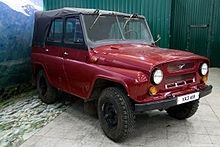
UAZ-469 in a museum
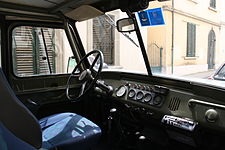
UAZ-469 interior
Engine
2,450 cc petrol, in-line 4-cylinder, water cooled, 75 hp (56 kW) at 4,000 rpm, 166.7 N·m (123.0 lb·ft) at 2,200 rpm
Fuel
Carburettor system, uses 76-octane petrol, tank capacity is 78 litres
Transmission
4-speed manual gearbox, 2-speed transfer case, 4-wheel drive
Front axle
Live axle with leaf springs, drum brakes
Rear axle
Live axle with leaf springs, drum brakes
Dimensions and weights
- Empty weight with fuel: 1,650 kg (3,638 lb)
- Max. gross weight: 2,450 kg (5,401 lb)
- External dimensions: (length/width/height): 4,025 mm (158.5 in) × 1,785 mm (70.3 in) × 2,050 mm (80.7 in)
- Wheelbase: 2,380 mm (93.7 in)
- Tread front/rear: 1,453 mm (57.2 in)/1,453 mm (57.2 in)
- Ground clearance: 220 mm (8.7 in)
- Tire size: 215 SR 15
- Wheel size: 6L×15
UAZ 469B Technical specifications and More info
- GAZ 69M Manufactured in 1972
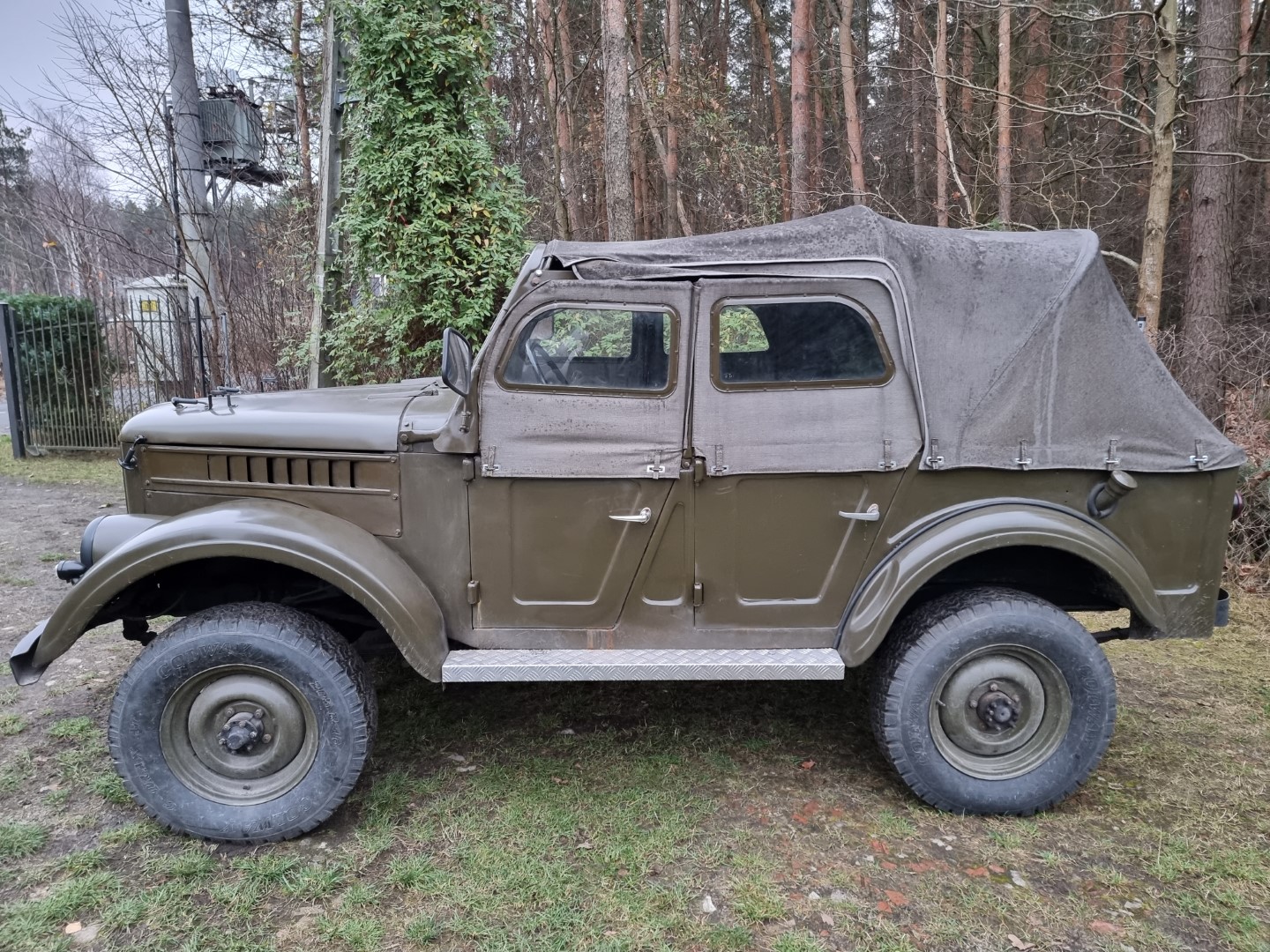 |
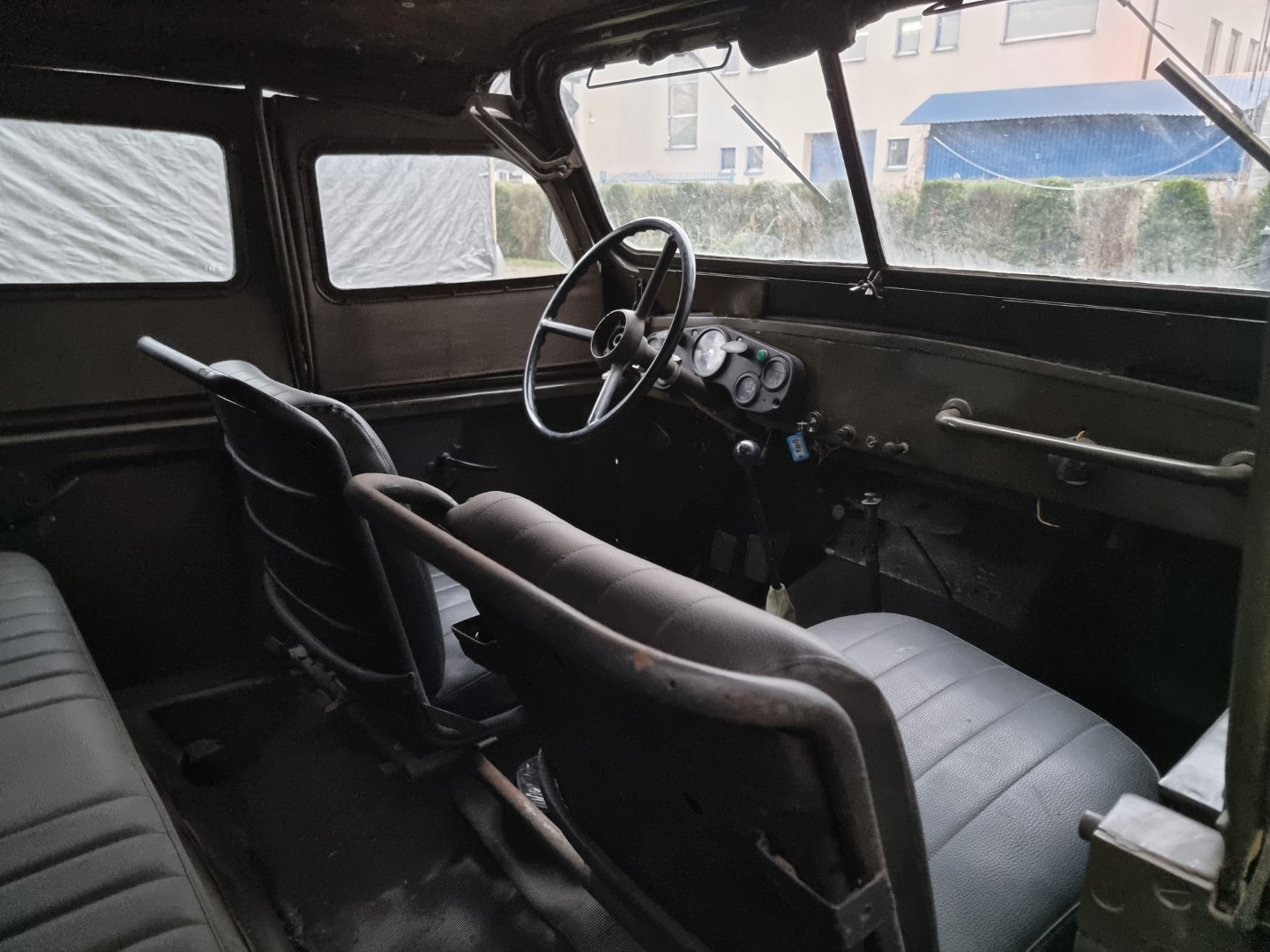 |
GAZ-69 History
Overview
Also called: Kaengsaeng 68Sungri 4.10
Production: 1953-1975
Assembly: Gorky, Ulyanovsk (USSR),
Chronology:
Predecessor: GAZ-67
Willys MB
Successor: UAZ-469
The GAZ-69 is a four-wheel drive off-road vehicle produced by GAZ (ГАЗ, or Gorkovsky Avtomobilnyi Zavod, Gorky Automobile Factory) between 1953 and 1956 and then by UAZ, in 1956–1972, though all of these light truck class vehicles were known as GAZ-69s. It was also produced in Romania until 1975.
Motorcycles
- DKW 125RT Manufactured in 1940

Years of production: 1939 - 1945
Overall production: 21000 of DKW RT 125 and 12000 of DKW RT 125-1? units
Engine: 4.75hp/4800rpm, 1-cyl, 2-stroke 123cc
Slit valves
Bore/Stroke: 52/58 mm
Compression: 6:1
Carburettor: Amal E 68/18, Bing AJ 1/16 N, Grätzin K 16/A; 16mm
Length: 196cm, width: 66cm, saddle height: 68cm
Wheelbase: 1230mm, clearance - 15cm
Gearbox: 3 speeds
Chain
Tube frame
Parallelogram front fork
Weight: 68 kg (aluminium block)
Maximal speed: 72(?75) km/h
Tyres: 2.50-19 inches
Fuel capacity: civil - 7.5L, Behördenausführung - 9 L
Fuel consumption: 2.3 L/100km
Introduction:
Dampf-Kraft Wagen (German: steam-powered vehicle) or DKW is a historic car and motorcycle marque. In 1916, the Danish engineer Jørgen Skafte Rasmussen founded a factory in Saxony, Germany, to produce steam fittings. In the same year, he attempted to produce a steam-driven car, called the DKW. Although unsuccessful, he made a two-stroke toy engine in 1919, called Des Knaben Wunsch "a boy's desire". He also put a slightly modified version of this engine into a motorcycle and called it Das Kleine Wunder "a little marvel". This was the real beginning of the DKW brand: by the 1930s, DKW was the world's largest motorcycle manufacturer. In 1932, DKW merged with Audi, Horch and Wanderer to form the Auto Union, and all brands continued until World War II. After the war, Auto Union changed ownership a couple of times, first passed into the hands of Daimler-Benz in 1957, and was finally purchased by the Volkswagen Group in 1964.
DKW motorcycles used 2-stroke engines which were technically advanced; the best-known one in the UK is the RT 125. As reparations after World War II, the design drawings of the RT125 were given to Harley-Davidson in the US and BSA in the UK. The HD version was known as the Hummer, while BSA used them for the Bantam. Designs from the DKW 2-stroke engine was also used in the Ariel Arrow and Leader.
During the War, DKW engineers also created the Cyclemaster (which was essentially a redesigned 1938 Sachs Saxonette auxiliary unit). The plans for that were also confiscated, and the contract for production awarded to EMI in Great Britain. As has been remarked before, from German engineers, America got the H-bomb while Britain got the Cyclemaster…
IFA and later MZ models continued in production until the 1990s, when economics finally brought production of the two stroke to an end. Other manufacturers also copied the DKW design, officially or otherwise, including Yamaha, Voskhod and Polish WSK.
Vintage DKW motorcycles enjoy an excellent reputation for design and engineering and are sought-after machines today. Spares are obtainable from Germany (some components were used in later MZ motorcycles, which makes spares availability much easier). There’s an active club in Germany, and Bernie of the British Two-Stroke Club runs an enthusiastic section for German machines in the UK.
- Junak M10 Manufactured in 1959
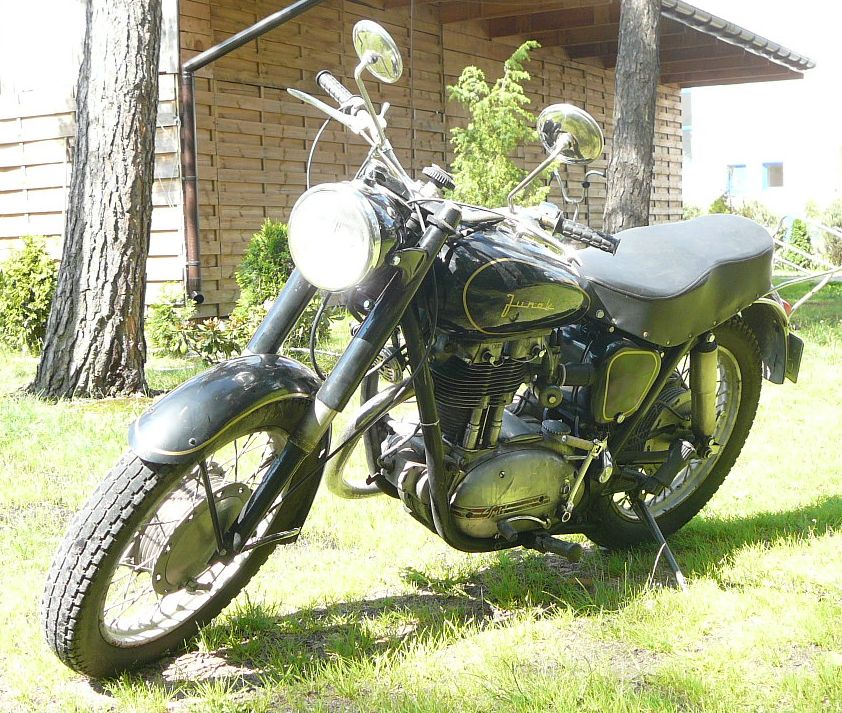 |
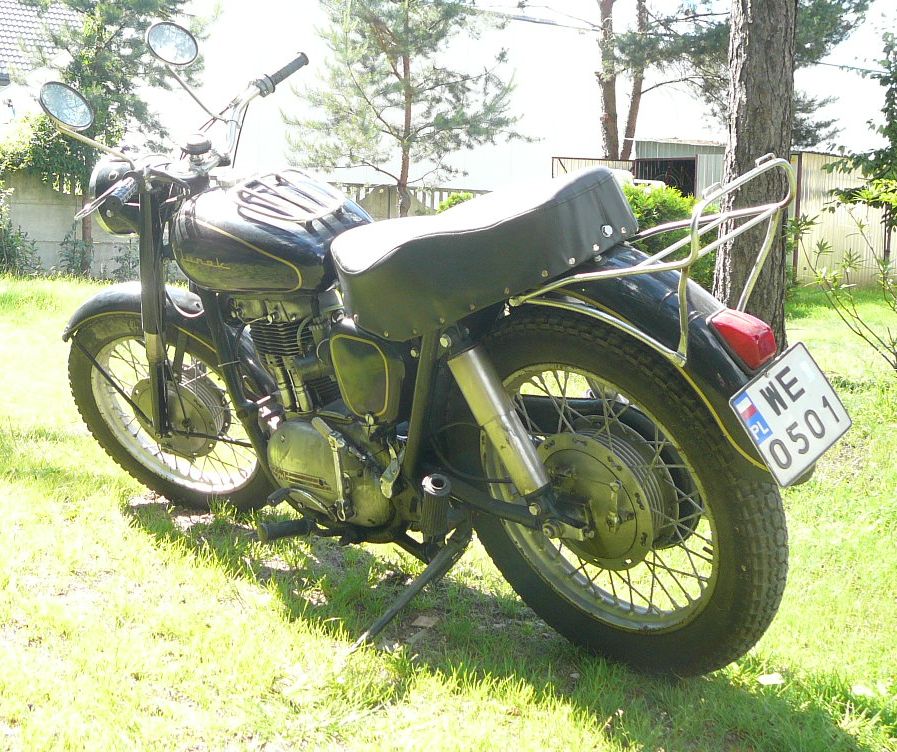 |

Junak: maintenance instructions in Polish
- OSA 175 Manufactured in 1965
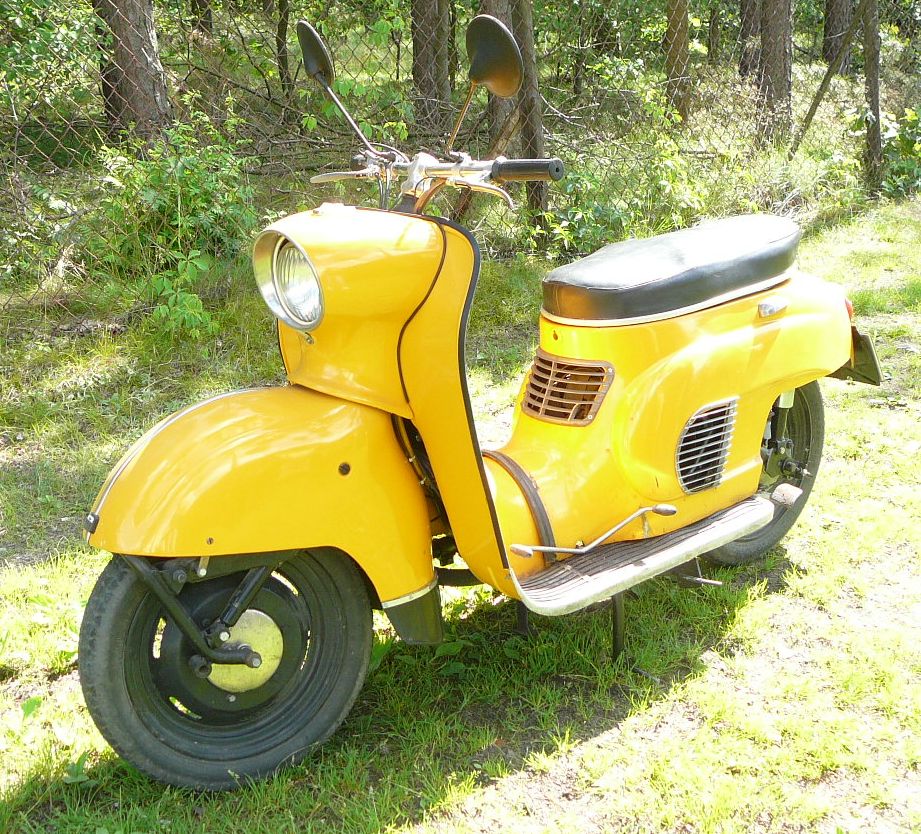 |
 |

- Romet
